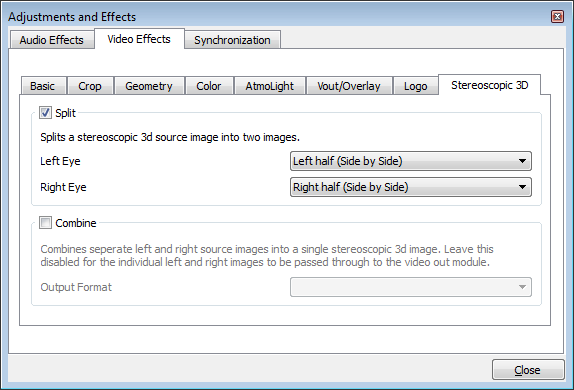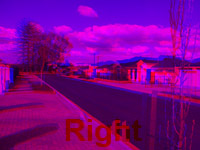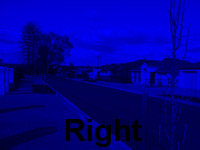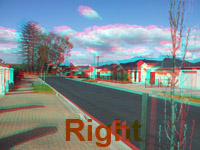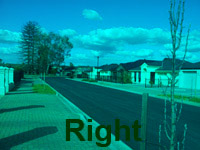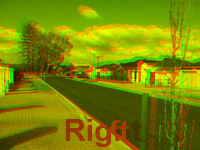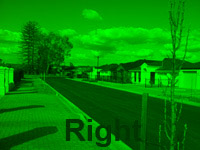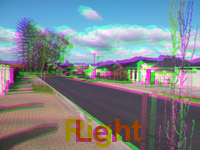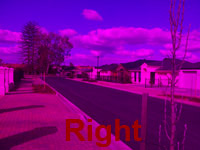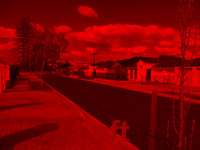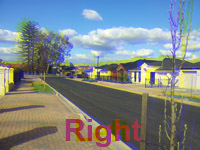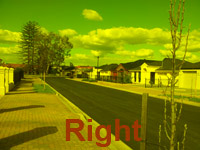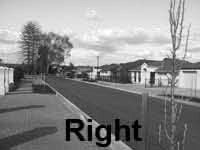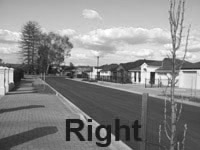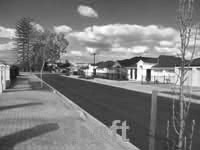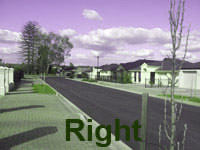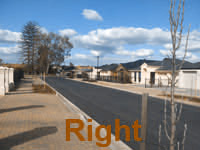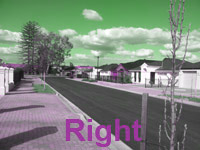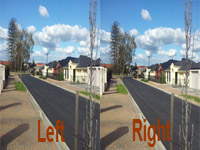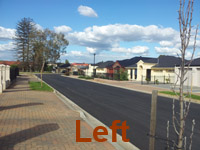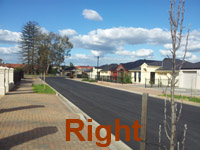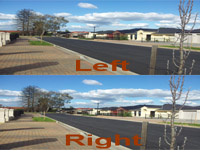Difference between revisions of "SoC 2011/Stereoscopic Video"
MessiahAndrw (talk | contribs) |
m (→Input formats: I guess this was intended) |
||
| (7 intermediate revisions by one other user not shown) | |||
| Line 2: | Line 2: | ||
Stereoscopic, or 3D, video support was implemented into the VLC Media Player as part of my Google Summer of Code project. It is currently experimental with a couple of bugs and I'm still actively working on it. At present you must build it from source, and I'm looking to soon merge it into the main tree. | Stereoscopic, or 3D, video support was implemented into the VLC Media Player as part of my Google Summer of Code project. It is currently experimental with a couple of bugs and I'm still actively working on it. At present you must build it from source, and I'm looking to soon merge it into the main tree. | ||
| + | |||
| + | I'm in need of hardware, if you would like to help out see [[#Donations|here]]. | ||
== Building from Source == | == Building from Source == | ||
| Line 170: | Line 172: | ||
| [[File:StereoLeft.jpg]] | | [[File:StereoLeft.jpg]] | ||
| top | | top | ||
| − | | The eye is encoded into the | + | | The eye is encoded into the top half of the image. Assumes the source is half-SBS but the aspect ratio will need to be halved for full-SBS. |
|- | |- | ||
| [[File:StereoTb.jpg]] | | [[File:StereoTb.jpg]] | ||
| Line 217: | Line 219: | ||
3D Vision will work straight out the box with the Direct3D (XP) vout. You don't need to do anything special, it'll activate as soon as the Direct3D vout starts receiving stereoscopic frames. | 3D Vision will work straight out the box with the Direct3D (XP) vout. You don't need to do anything special, it'll activate as soon as the Direct3D vout starts receiving stereoscopic frames. | ||
| − | == Planned Features == | + | == AMD HD3D == |
| + | I would really love to start working on supporting AMD HD3D, but I need your help, see [[#Donations|here]]. | ||
| + | |||
| + | |||
| + | == Quad Buffered OpenGL == | ||
| + | There is some experimental code for quad-buffered OpenGL if you build from source. I highly doubt it will work since I currently lack the hardware needed to test it. Help speed up development, see [[#Donations|here]]. | ||
| + | |||
| + | == Other Planned Features == | ||
* ''A vout-independent anaglyph combining filter.'' This will combine the images for both eyes into a single anaglyph image before being passed to the vout. This will make it possible to display stereoscopic content with non-stereoscopic-aware vouts. | * ''A vout-independent anaglyph combining filter.'' This will combine the images for both eyes into a single anaglyph image before being passed to the vout. This will make it possible to display stereoscopic content with non-stereoscopic-aware vouts. | ||
| − | |||
| − | |||
* ''3D TV output.'' Non-HDMI 1.4 3D outputs - e.g. outputting side-by-side checkerboard, row interleaved, etc. | * ''3D TV output.'' Non-HDMI 1.4 3D outputs - e.g. outputting side-by-side checkerboard, row interleaved, etc. | ||
* ''Other proprietary shutter glasses''. For example e-Dimensional. | * ''Other proprietary shutter glasses''. For example e-Dimensional. | ||
| − | * ''More input | + | * ''More input formats''. Column and row interleaved input sources. |
| + | |||
| + | == Donations == | ||
| + | The best way you can help me out is by donating hardware. Any hardware you donate will become my top priority to add support for. If you do wish to donate, please contact me by e-mail at messiahandrw-at-gmail-dot-com (my shipping address is in Australia). I'll accept any hardware that you wish to donate, however the following will be especially useful: | ||
| + | |||
| + | * AMD Radeon HD 5xxx or 6xxx. | ||
| + | * AMD FirePro Vx800, Vx7x0 | ||
| + | * HDMI 1.4 compliant 3D TVs | ||
| + | * 120Hz monitors | ||
| + | |||
| + | If instead you'd like to donate money for me to purchase the above hardware, see [http://pledgie.com/campaigns/16038 my pledge]. | ||
== Troubleshooting & Support == | == Troubleshooting & Support == | ||
Latest revision as of 16:49, 23 September 2011
This project is part of Google Summer of Code 2011.
|
Stereoscopic, or 3D, video support was implemented into the VLC Media Player as part of my Google Summer of Code project. It is currently experimental with a couple of bugs and I'm still actively working on it. At present you must build it from source, and I'm looking to soon merge it into the main tree.
I'm in need of hardware, if you would like to help out see here.
Contents
Building from Source
At the present state you must acquire the source code of the stereoscopic 3D branch and build it yourself. https://github.com/MessiahAndrw/Stereoscopic-VLC
A build (that my be out of date by the time you read this) is available here: http://streams.videolan.org/misc/stereo/vlc-1.2.0-git-stereoscopy.zip�
There are build instructions in a file named 'STEREOSCOPY README' but I'll also repeat the instructions here.
Build Environment
I use 32-bit MSYS/x86 Windows 7. To set up your build environment first follow through the instructions on [Win32CompileMSYSNew] to make sure you're able to build VLC successfully on your system.
The following build instructions should work on any Windows system.
Building
Create a new empty directory somewhere, and at the MSYS terminal type:
git pull git://github.com/MessiahAndrw/Stereoscopic-VLC.git
To bootstrap the build I use the following:
cd vlc cp -v /usr/win32/share/aclocal/* m4/ cp -v /usr/share/aclocal/* m4/ PATH=/usr/win32/bin:$PATH ./bootstrap
Then to configure:
sh extras/package/win32/configure-msys.sh
Finally to build:
PATH=/usr/win32/bin:$PATH make package-win32 -j6
(The -j6 switch is optional and tells makefile to use 6 threads, it speeds up the build time on my 6-core machine.)
'make package-win32' will exit with the following error but that's normal and VLC has still been built:
cp: cannot stat `./npapi-vlc/installed/lib/npvlc.dll': No such file or directory
If everything else was successful you will now have built VLC with stereoscopic support! You will find this build in the directory 'vlc-1.2.0-git'.
Note on 3D Vision support
nVidia 3D Vision only activates for windowed-mode programs which are supported by the nVidia driver. At the present state VLC is not supported by the nVidia driver. However, the driver only performs a simple file-name check of the application, so as a workaround you can rename vlc.exe to the same file-name as a supported application. This can be done simply by:
cd vlc-1.2.0-git mv vlc.exe wow.exe
Splitting
To play a stereoscopic 3D video you must tell the stereoscopy module how to get the image for each eye. The stereoscopic module is takes a 2D input picture, and produces 2 output pictures (one for the left eye, and one for the right eye).
Command line
To enable the stereoscopic module you should add the following command line parameters when you start vlc:
--video-filter="stereoscopy" --stereoscopy-left="<left>" --stereoscopy-right="<right>"
Where <left> and <right> are valid input formats (see the table below).
QT4
You can configure the stereoscopy module through the QT4 interface. To do this, open the 'Tools' menu and click on 'Effects and Filters'. In the 'Adjustments and Effects' dialog that opens navigate to the 'Video Effects' tab. Then find the sub-tab titled 'Stereoscopy'. Check 'Split' to enable the stereoscopy module to split the image into separate left and right frames. Select your video's input formats for the 'Left Eye and the 'Right Eye'.
Input formats
Developer notes
picture_t contains a new field i_eye that is the eye the picture represents. Valid values at the moment are:
| 0 | The picture is 2D. |
| 1 | The picture is destined for the left eye. |
| 2 | The picture is destined for the right eye. |
Flags:
| STEREO_WAIT_FOR_NEXT_FRAME_BIT | Do not present straight away and instead wait for the next frame. |
The default value for i_eye is 0, and all present video codecs output frames where i_eye is 0. It is up to the stereoscopy module to split it into left and right. But it's possible for someone to develop a video codec that output pictures where i_eye>0, for example for a container format where the data is stored as separate left/right images. In this case the stereoscopy module does nothing, and forwards the pictures on as is.
Mask i_eye by STEREO_EYE_MASK to get the eye number without any flags. It is possible that two images represent the same point in time (this is only untrue for field sequential video). If the STEREO_WAIT_FOR_NEXT_FRAME_BIT is set then the vout shouldn't present the frame straight away, but expect another picture immediately joining it representing the other eye at the same point of time, and display them together at once.
nVidia 3D Vision
The focus of the Google SoC project has been on nVidia 3D Vision. To use 3D Vision you require the following:
- A compatible nVidia GPU
- nVidia 3D Vision Kit (the glasses you wear)
- A 120Hz LCD or 100Hz CRT monitor
- Windows
You also have to rename 'vlc.exe' since VLC isn't yet supported by the nVidia drivers. I'd recommend 'wow.exe' or 'googleearth.exe'. Also, make sure you have 3D Vision enabled in the nVidia control panel.
3D Vision will work straight out the box with the Direct3D (XP) vout. You don't need to do anything special, it'll activate as soon as the Direct3D vout starts receiving stereoscopic frames.
AMD HD3D
I would really love to start working on supporting AMD HD3D, but I need your help, see here.
Quad Buffered OpenGL
There is some experimental code for quad-buffered OpenGL if you build from source. I highly doubt it will work since I currently lack the hardware needed to test it. Help speed up development, see here.
Other Planned Features
- A vout-independent anaglyph combining filter. This will combine the images for both eyes into a single anaglyph image before being passed to the vout. This will make it possible to display stereoscopic content with non-stereoscopic-aware vouts.
- 3D TV output. Non-HDMI 1.4 3D outputs - e.g. outputting side-by-side checkerboard, row interleaved, etc.
- Other proprietary shutter glasses. For example e-Dimensional.
- More input formats. Column and row interleaved input sources.
Donations
The best way you can help me out is by donating hardware. Any hardware you donate will become my top priority to add support for. If you do wish to donate, please contact me by e-mail at messiahandrw-at-gmail-dot-com (my shipping address is in Australia). I'll accept any hardware that you wish to donate, however the following will be especially useful:
- AMD Radeon HD 5xxx or 6xxx.
- AMD FirePro Vx800, Vx7x0
- HDMI 1.4 compliant 3D TVs
- 120Hz monitors
If instead you'd like to donate money for me to purchase the above hardware, see my pledge.
Troubleshooting & Support
There are several issues I am aware of. If you need support directly from me or have any enquiries then feel free to e-mail me directly at messiahandrw-at-gmail-dot-com (also mention Stereoscopic VLC in the subject so I don't mistake it for spam).
VLC Crashes when I click stop
I know about this bug and I'm trying to fix it, so stay tuned!
The frame rate is too slow
The stereoscopy module is alternating outputting left and right frames, because VLC starts to drop frames when I start doubling the frame rate. I'm working on a way around this (and if you're a developer I'd love for some input on this!)
My Video is black!
Either there's a bug I don't know about, or the stereoscopy module doesn't support your particular colour encoding. Check VLC's messages to see if anything is being reported (Tools > Messages). Either way, e-mail me and I'll get straight on to it!
3D Vision isn't working
This could be any number of things:
- 3D Vision is not enabled in the nVidia control panel.
- You haven't renamed vlc.exe (see above).
- You're not using the Direct3D vout.
- The stereoscopy module is turned off.
- You don't have the latest nVidia drivers.
I'd love to solve your issue, but please check VLC's messages for any warnings and errors before contacting me.
